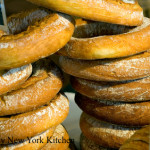All good Southerners and their friends know that the secret to a prosperous New Year is to eat black eyed peas on New Year’s Day!
Cooking Instructions:
Check beans for debris and organic matter. Rinse thoroughly. Mix beans with aromatic vegetables (celery, carrot, onion, etc.) and a few spoonfuls of olive oil. Cover with two inches of water and then bring to a full boil for 15 minutes. Reduce heat to a simmer and cook gently until done. Salt when beans are soft. A pre-soak will lessen the cooking time.
“Work With What You Got!”
©Tiny New York Kitchen © 2021 All Rights Reserved
Lucky Foods For New Year’s Day
This New Year’s make a resolution to bring yourself a heaping helping of good luck. It’s as easy as just making dinner.
In cultures around the world, the new year is celebrated with particular foods and recipes thought to bring good fortune. Symbolizing wealth, long life, and prosperity, lucky foods are an auspicious and delicious way to celebrate the holiday and welcome good things in the coming year.
Pork & Sauerkraut
Tender braised pork, along with other forms of pork (like sausages and roasts) is a symbol of abundance in Celtic and Chinese cultures, and is popular amongst the Pennsylvania Dutch on New Year’s Day. Paired with the cabbage in sauerkraut, a Chinese symbol of wealth and prosperity, this easy braise with apples and onions is one tasty pot of good luck.
Black Eyed Peas, Greens & Cornbread
Traditionally eaten in the South on New Year’s Day, this trifecta of ingredients represents three different types of money. Leafy greens represent dollar bills, the round peas symbolize coins and cornbread is the color of gold.
Grapes
According to Spanish lore, eating 12 grapes as the clock chimes midnight on New Year’s Eve will bring you 12 months of good luck. Incorporate this tasty tradition by adding grapes to your holiday cheese board or dessert platter. Or try a delicious side dish with savory sautéed Brussels sprouts, grapes, and crunchy walnuts.
Pomegranates
In Greece, smashing a pomegranate on the floor to release the seeds is a surefire way to bring good luck. The seeds represent abundance and fertility. The more seeds you see, the luckier you’ll be. Instead of smashing, sprinkle that good fortune over peak season oranges, mixed greens, and prosciutto for a colorful celebration of a salad.
Fish
Fish are thought to represent progress and abundance because they constantly swim forward and group together in schools. In Czech culture, the scales of the fish are considered lucky because they resemble silver coins and if you carry a silver coin in your wallet it is said that your money will never run out. Celebrate the new year abundantly with a fish dish that everyone will enjoy.
Noodles
No Chinese New Year, Lunar New Year, celebration is complete without a bowl of noodles. Symbolizing longevity and health, noodles are always left whole. Breaking or cutting a long strand of noodles is considered bad luck. Nourish a long life with a longevity noodles dish.
Cake
Ring shaped cakes, like Bundt cakes, are a sweet way to celebrate coming full circle from the previous year. In cultures around the Mediterranean, a coin is baked into the cake and thought to bring wealth and good fortune to the lucky recipient who finds it. Bake a delicious ring-shaped cake and be sure to warn your guests if you decide to bake it with a coin hidden inside.
©Tiny New York Kitchen © 2020 All Rights Reserved
Lucky Foods To Ring In The New Year
Many cultures believe that some foods are lucky and prepare them on New Year’s to ensure good fortune throughout the upcoming year.
Bagels & Doughnuts. Round foods, like bagels and doughnuts, are a great way to start the day and also symbolize coming full circle. As the year is coming to an end, it’s a good reminder that the New Year is about to begin.
Noodles. In China and Japan, long noodles represent longevity, BUT only if you don’t cut or break the noodles. You may want to make some soba noodles in a nice broth for a New Year’s lunch.
Lentils. Lentils resemble coins and plump when you cook them, which symbolizes growing wealth. Pork sausage cooked with lentils (Cotechino Con Lenticchie) Is a traditional New Year’s dish in Italy.
Fish. Whole fish (head to tail) is said to give you good luck from the beginning of the year to the very end of the year. Roasting a whole fish not only keeps it moist, but also adds extra flavor.
Pork. Pigs typically root forward while planting their feet in the ground. This signifies moving forward. In Spain it is traditional to prepare pork chops with grapes. It is customary to eat 12 grapes at the stroke of midnight in order to bring prosperity in each of the coming months.
Corn. The color of gold, which indicates a year of riches. You may want to make a cornbread to go with your New Year’s meal.
Collard Greens & Black Eyed Peas. This is a traditional Southern combination. The greens look like paper money and the black-eyed peas resemble coins. This dish is not only delicious, but also healthy.
Bundt Cake. Like bagels and doughnuts, a round Bundt cake is a delicious reminder that every new beginning comes from some other beginning’s end.
Don’t Be Greedy. While it’s tempting to eat as much of these “lucky” foods that are thought to give you the most prosperous year yet, it’s important not get too greedy. Leaving food on your plate after midnight is associated with a fully stocked pantry in the New Year.
Tiny New York Kitchen Wishes You And Your Family A Very Healthy & Happy New Year!
“Work With What You Got!”
© Victoria Hart Glavin Tiny New York Kitchen © 2015 All Rights Reserved










